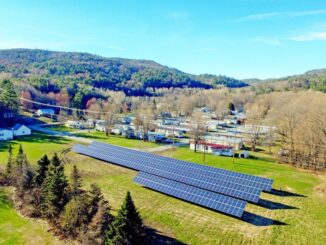
America’s renewable energy drive needs more than a million miles of new transition lines but emerging resistance includes opponents worried about building them in one of the country’s richest areas of ice-age fossils.
The Greenlink West project would build a 470-mile-long transmission line bringing clean electricity north to Reno in Nevada, but it cuts through an area containing everything from woolly mammoth tusks to giant sloths to ancient camels.
The pushback has highlighted a major, and growing, challenge to Joe Biden’s attempts to expand clean energy in order to tackle the climate crisis – how to quickly build vast new networks of electricity transmission across America without falling afoul of local communities and green groups.
If the US is to eliminate planet-heating emissions by 2050 it will need to increase the capacity of its current 700,000 circuit-mile network of poles and wires by threefold, researchers have estimated, in order to electrify key components of everyday life and shift intermittent wind and solar energy to areas where the sun isn’t shining or wind isn’t blowing.
The nascent stages of this gargantuan effort, the scale of which hasn’t been seen since the US built out its highway system in the 1950s, is already facing opposition from various conservation groups, locals and fossil fuel interests from New England to the Arizona desert.
“Transmission is contentious because it’s long, it’s linear, so it affects a lot of people,” said Jessica Wilkinson, North America renewable energy team lead at the Nature Conservancy. “We are seeing local concerns being raised and they are growing as these projects increase in size. It’s all new to people.”
Suddenly, as lawmakers jostle over ways to speed up new projects, local opposition seems likely to grow. “It’s only been energy nerds like me into this, most people haven’t really thought about it,” said Tim Latimer, chief executive of Fervo Energy, a developer of geothermal projects.
“But this is the next big barrier to renewables. There really is no transition without transmission.”
Those committed to preventing the defilement of valued landscapes are now placed in a conundrum where an unprecedented amount of infrastructure development is needed to protect those landscapes, as well as people, from global heating.
Sherri Grotheer, president of the Protectors of Tule Springs Fossil Beds, said that she is “very concerned” about climate crisis but that she wanted federal authorities to come up with an alternative route for Greenlink than slicing through the Nevada monument, which could disturb fossils that are hundreds of thousands of years old.
“Sometimes knee-jerk reactions can cause unintended consequences and we know there are innumerable fossils left here, there is evidence of fossils everywhere just under the surface,” she said of Tule Springs, a 23,000-acre monument situated north of Las Vegas protected for its fossils under the auspices of the National Park Service since 2014.
“It’s one of the most significant fossil sites in the continental US and maybe beyond,” said Grotheer. “It’s just very cool. I just want them to look at alternative routes. There is also the concern of putting projects like this in national parks, because then you think ‘where does this end?’”
For developers of renewable energy projects, however, the lack of transmission capacity is a major headache. Even as clean energy projects have gathered pace, turbocharged by last year’s $370bn in climate spending via the Inflation Reduction Act, they face frustrating waits to be connected to a fragmented, congested electricity grid.
I can’t tell you how many places we’ve seen and thought, ‘Wow, the geology is excellent for geothermal, but we just can’t get the transmission’
Tim Latimer
The typical wait is now nearly four years, with much longer delays than this experienced by some companies. While the tap of new funding for renewables is now gushing, it risks being wasted due to the lack of a a metaphorical hosepipe.
The US Department of Energy has said there is a “pressing need” for new infrastructure, with California alone needing to add more than $9bn-worth of new transmission to avoid rolling power blackouts as wildfires and other climate-driven disruptions mount.
“We need to solve this problem if we are going to deal with climate change,” said Latimer. Fervo has been able to establish geothermal projects in Utah and Nevada – tapping into the steam from underground heat to spin turbines – but Latimer said other opportunities have been hampered by the lack of grid opportunities.
“I can’t tell you how many places we’ve seen and thought, ‘Wow, the geology is excellent for geothermal, but we just can’t get the transmission,’” he said.
“It’s difficult to get private finance for something where you can’t get revenues for nine more years, so you just give up. The system is gummed up but that is just the tip of the iceberg because many people don’t even try to get a spot in the line.”
Wilkinson said that smart planning can avoid disturbing valued landscapes and help reduce this tension. A recent report she co-authored found that while an area the size of Texas is needed for new renewable projects and their power lines in the US, this can be shrunk by more than half if sited in an efficient way, avoiding sensitive habitats and prized cropland.
“We have the dual crises of climate change and biodiversity loss and there is an assumption we will need to trade off a lot on the nature side to fix climate change, but that’s not the case,” she said. “Time is of the essence, we need to transition to renewables quickly, but there is a way to do it smartly that can balance conservation and development.”
Congress is now grappling with how to speed up the permitting of new transmission projects, as part of the negotiations over the debt ceiling.
Republicans and Joe Manchin, the centrist Democrat senator, want to weaken environmental impact reviews of new developments, a prospect that environmental groups are wary of as an avenue for fossil fuel projects such as the Mountain Valley Pipeline, a gas project championed by Manchin that gained a key approval from the Biden administration earlier this month.
The White House, meanwhile, has indicated it supports expedited permitting, but not a wholesale watering down of environmental laws. “Right now, the permitting process for clean energy infrastructure, including transmission, is plagued by delays and bottlenecks,” admitted John Podesta, a senior Biden climate adviser, in a speech last week.
Podesta said he recently learned that a transmission line he thought was approved under Barack Obama’s presidency still hadn’t been resolved. “That’s unacceptable,” he said. “We got so good at stopping projects that we forgot how to build things in America.”



